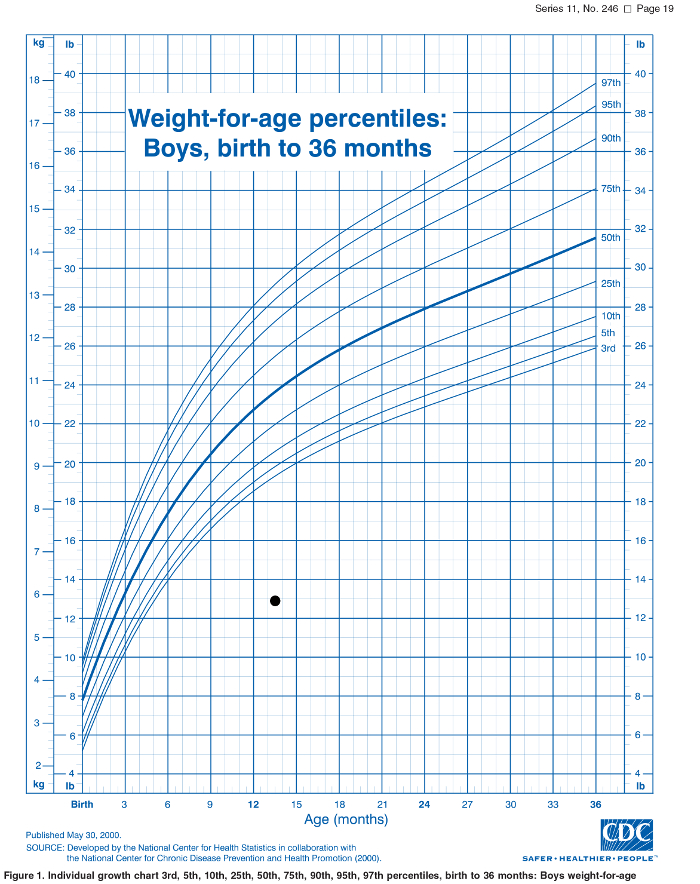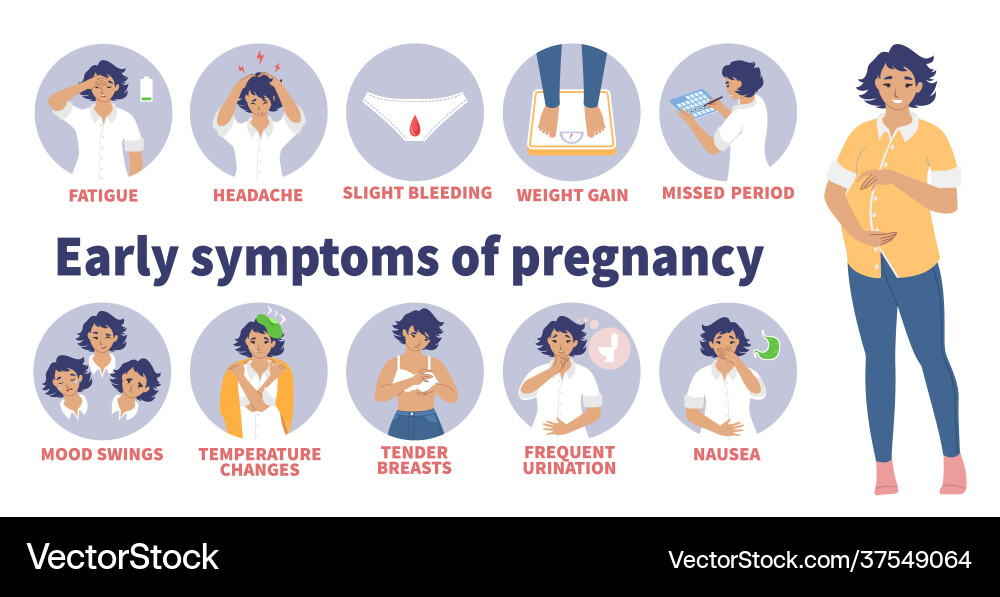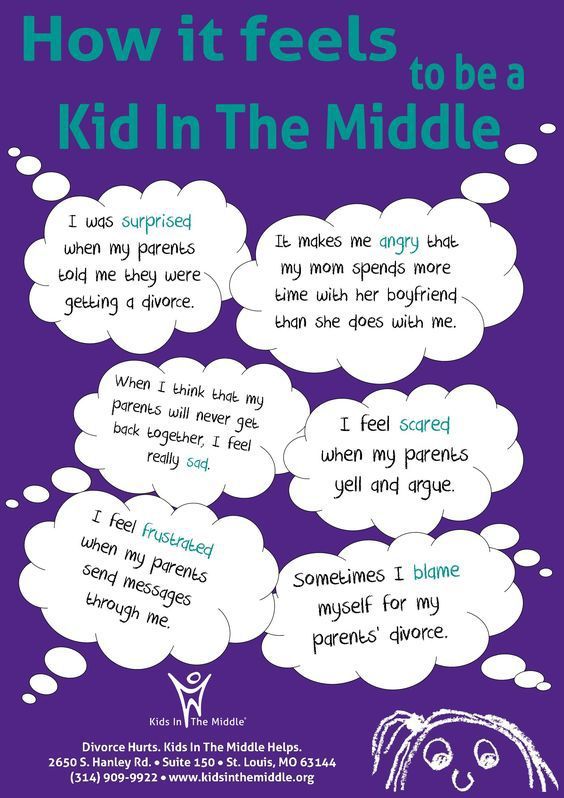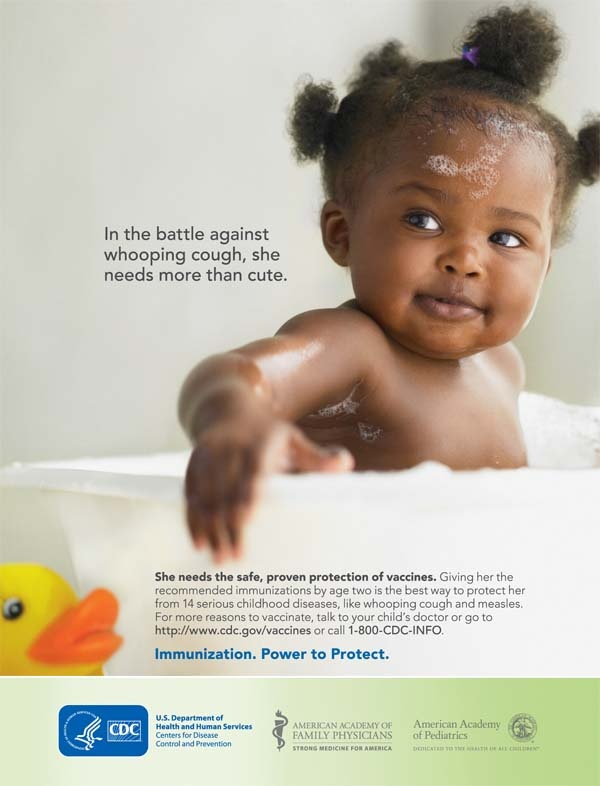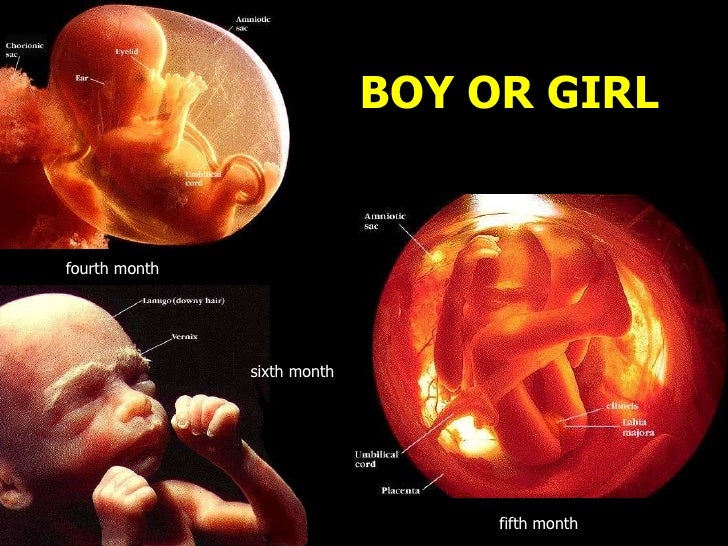How to help acid reflux in child
GERD (Gastroesophageal Reflux Disease) in Children
What is GERD?
GERD, or gastroesophageal reflux disease, is a long-term (chronic) digestive disorder. It happens when stomach contents flow back up (reflux) into the food pipe (esophagus).
GERD is a more serious and long-lasting form of gastroesophageal reflux (GER).
GER is common in babies under 2 years old. Most babies spit up a few times a day during their first 3 months. GER does not cause any problems in babies. In most cases, babies outgrow this by the time they are 12 to 14 months old.
It is also common for children and teens ages 2 to 19 to have GER from time to time. This doesn’t always mean they have GERD.
When GER becomes GERD
Your baby, child, or teen may have GERD if:
- Your baby’s symptoms prevent him or her from feeding. These symptoms may include vomiting, gagging, coughing, and trouble breathing.
- Your baby has GER for more than 12 to 14 months
- Your child or teen has GER more than 2 times a week, for a few months
What causes GERD?
GERD is often caused by something that affects the LES, the lower esophageal sphincter. The LES is a muscle at the bottom of the food pipe (esophagus). The LES opens to let food into the stomach. It closes to keep food in the stomach. When the LES relaxes too often or for too long, stomach acid flows back into the esophagus. This causes vomiting or heartburn.
Everyone has reflux from time to time. If you have ever burped and had an acid taste in your mouth, you have had reflux. Sometimes the LES relaxes at the wrong times. Often your child will just have a bad taste in his or her mouth. Or your child may have a short, mild feeling of heartburn.
Babies are more likely to have a weak LES. This makes the LES relax when it should stay shut. As food or milk is digesting, the LES opens. It lets the stomach contents go back up to the esophagus. Sometimes the stomach contents go all the way up the esophagus. Then the baby or child vomits. In other cases, the stomach contents only go part of the way up the esophagus. This causes heartburn or breathing problems. In some cases there are no symptoms at all.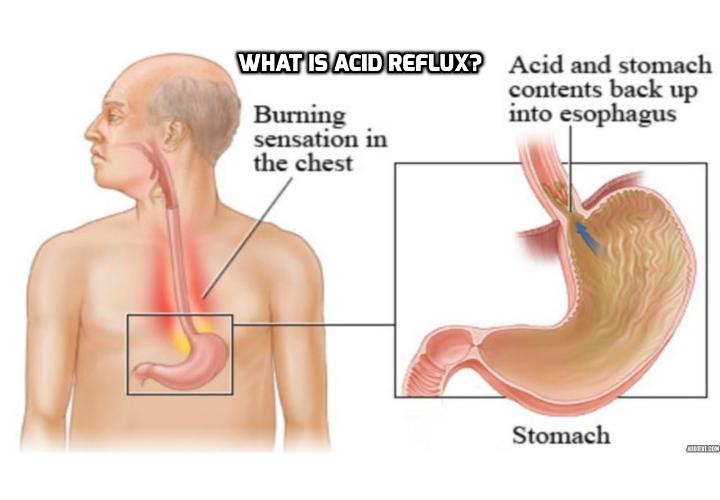
Some foods seem to affect the muscle tone of the LES. They let the LES stay open longer than normal. These foods include:
- Chocolate
- Peppermint
- High-fat foods
Other foods cause the stomach to make more acid. These foods include:
- Citrus foods
- Tomatoes and tomato sauces
Other things that may lead to GERD include:
- Being obese
- Medicines, including some antihistamines, antidepressants, and pain medicines
- Being around secondhand smoke
What are the risk factors for GERD?
GERD is very common during a baby’s first year of life. It often goes away on its own. Your child is more at risk for GERD if he or she has:
- Down syndrome
- Neuromuscular disorders such as muscular dystrophy and cerebral palsy
What are the symptoms of GERD?
Heartburn, or acid indigestion, is the most common symptom of GERD. Heartburn is described as a burning chest pain. It begins behind the breastbone and moves up to the neck and throat. It can last as long as 2 hours. It is often worse after eating. Lying down or bending over after a meal can also lead to heartburn.
It begins behind the breastbone and moves up to the neck and throat. It can last as long as 2 hours. It is often worse after eating. Lying down or bending over after a meal can also lead to heartburn.
Children younger than age 12 will often have different GERD symptoms. They will have a dry cough, asthma symptoms, or trouble swallowing. They won’t have classic heartburn.
Each child may have different symptoms. Common symptoms of GERD include:
- Burping or belching
- Not eating
- Having stomach pain
- Being fussy around mealtimes
- Vomiting often
- Having hiccups
- Gagging
- Choking
- Coughing often
- Having coughing fits at night
Other symptoms may include:
- Wheezing
- Getting colds often
- Getting ear infections often
- Having a rattling in the chest
- Having a sore throat in the morning
- Having a sour taste in the mouth
- Having bad breath
- Loss or decay of tooth enamel
GERD symptoms may seem like other health problems.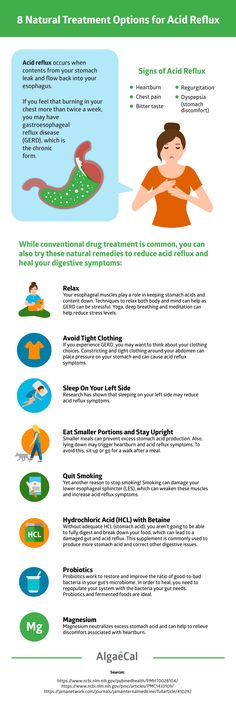 Make sure your child sees his or her healthcare provider for a diagnosis.
Make sure your child sees his or her healthcare provider for a diagnosis.
How is GERD diagnosed?
Your child's healthcare provider will do a physical exam and take a health history. Other tests may include:
- Chest X-ray. An X-ray can check for signs that stomach contents have moved into the lungs. This is called aspiration.
- Upper GI series or barium swallow. This test looks at the organs of the top part of your child’s digestive system. It checks the food pipe (esophagus), the stomach, and the first part of the small intestine (duodenum). Your child will swallow a metallic fluid called barium. Barium coats the organs so that they can be seen on an X-ray. Then X-rays are taken to check for signs of sores or ulcers, or abnormal blockages.
- Endoscopy. This test checks the inside of part of the digestive tract. It uses a small, flexible tube called an endoscope. It has a light and a camera lens at the end.
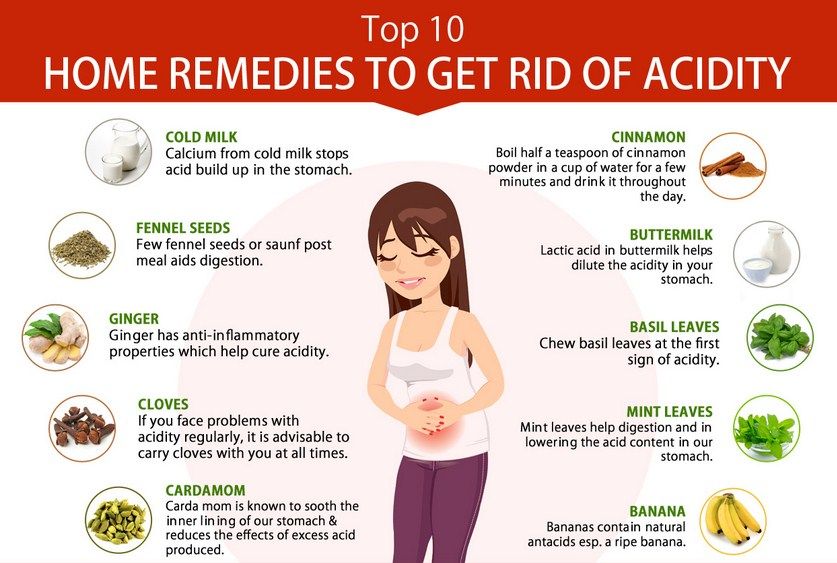 Tissue samples from inside the digestive tract may also be taken for testing.
Tissue samples from inside the digestive tract may also be taken for testing. - Esophageal manometry. This test checks the strength of the esophagus muscles. It can see if your child has any problems with reflux or swallowing. A small tube is put into your child’s nostril, then down the throat and into the esophagus. Then it measures the pressure that the esophageal muscles make at rest.
- pH monitoring. This test checks the pH or acid level in the esophagus. A thin, plastic tube is placed into your child’s nostril, down the throat, and into the esophagus. The tube has a sensor that measures pH level. The other end of the tube outside your child’s body is attached to a small monitor. This records your child’s pH levels for 24 to 48 hours. During this time your child can go home and do his or her normal activities. You will need to keep a diary of any symptoms your child feels that may be linked to reflux. These include gagging or coughing.
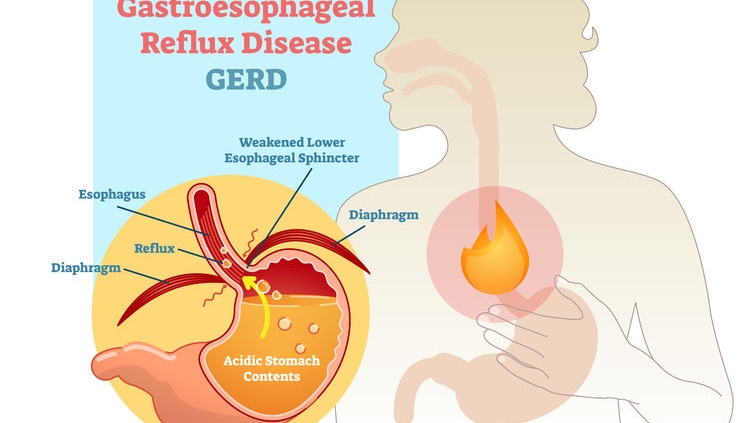 You should also keep a record of the time, type of food, and amount of food your child eats. Your child’s pH readings are checked. They are compared to your child’s activity for that time period.
You should also keep a record of the time, type of food, and amount of food your child eats. Your child’s pH readings are checked. They are compared to your child’s activity for that time period. - Gastric emptying study. This test is done to see if your child’s stomach sends its contents into the small intestine properly. Delayed gastric emptying can cause reflux into the esophagus
How is GERD treated?
Treatment will depend on your child’s symptoms, age, and general health. It will also depend on how severe the condition is.
Diet and lifestyle changes
In many cases, diet and lifestyle changes can help to ease GERD. Talk with your child’s healthcare provider about changes you can make. Here are some tips to better manage GERD symptoms.
For babies:
- After feedings, hold your baby in an upright position for 30 minutes.
- If bottle-feeding, keep the nipple filled with milk. This way your baby won’t swallow too much air while eating.
 Try different nipples. Find one that lets your baby's mouth make a good seal with the nipple during feeding.
Try different nipples. Find one that lets your baby's mouth make a good seal with the nipple during feeding. - Adding rice cereal to feeding may be helpful for some babies.
- Burp your baby a few times during bottle-feeding or breastfeeding. Your child may reflux more often when burping with a full stomach.
For children:
- Watch your child's food intake. Limit fried and fatty foods, peppermint, chocolate, drinks with caffeine such as sodas and tea, citrus fruit and juices, and tomato products.
- Offer your child smaller portions at mealtimes. Add small snacks between meals if your child is hungry. Don’t let your child overeat. Let your child tell you when he or she is hungry or full.
- If your child is overweight, contact your child’s provider to set weight-loss goals.
- Serve the evening meal early, at least 3 hours before bedtime.
Other things to try:
- Ask your child's provider to review your child’s medicines.
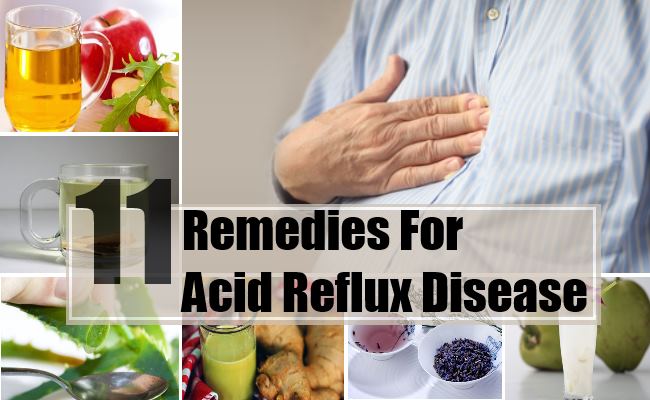 Some may irritate the lining of the stomach or esophagus.
Some may irritate the lining of the stomach or esophagus. - Don’t let your child lie down or go to bed right after a meal.
- Always check with your baby’s provider before raising the head of the crib if he or she has been diagnosed with gastroesophageal reflux. This is for safety reasons and to reduce the risk for SIDS and other sleep-related infant deaths.
Medicines and other treatments
Your child’s healthcare provider may also recommend other options.
Medicines. Your child's provider may prescribe medicines to help with reflux. There are medicines that help reduce the amount of acid the stomach makes. This reduces the heartburn linked to reflux. These medicines may include:
- h3-blockers. These reduce the amount of acid your stomach makes by blocking the hormone histamine. Histamine helps to make acid.
- Proton pump inhibitors. These help keep your stomach from making acid.
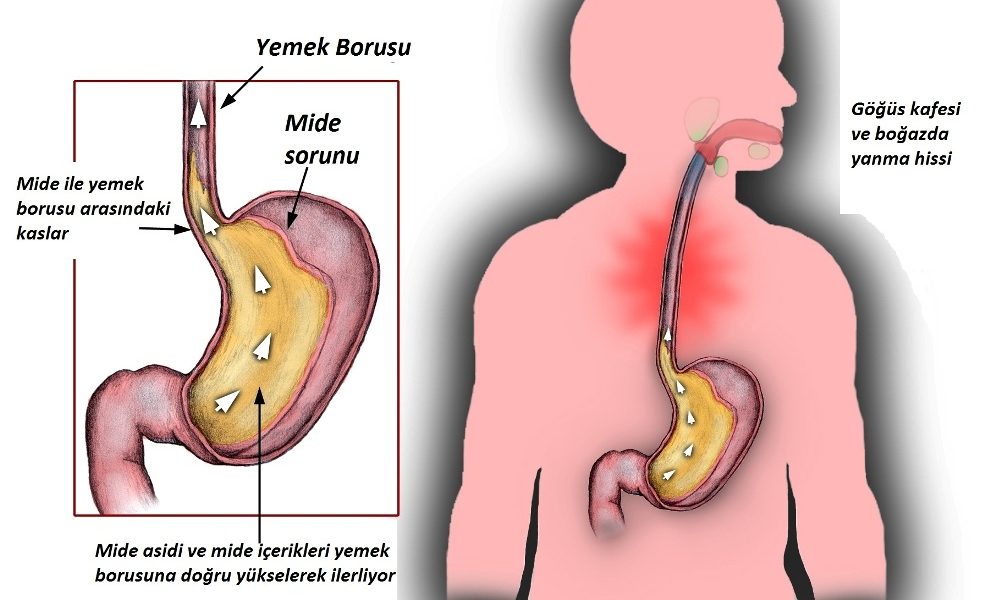 They do this by stopping the stomach's acid pump from working.
They do this by stopping the stomach's acid pump from working.
The provider may prescribe another type of medicine that helps the stomach empty faster. If food doesn’t stay in the stomach as long as normal, reflex may be less likely to occur.
Calorie supplements. Some babies with reflux can’t gain weight because they vomit often. If this is the case, your child's healthcare provider may suggest:
- Adding rice cereal to baby formula
- Giving your baby more calories by adding a prescribed supplement
- Changing formula to milk- or soy-free formula if your baby may have an allergy
Tube feedings. In some cases tube feedings may be recommended. Some babies with reflux have other conditions that make them tired. These include congenital heart disease or being born too early (premature). These babies often get sleepy after they eat or drink a little. Other babies vomit after having a normal amount of formula.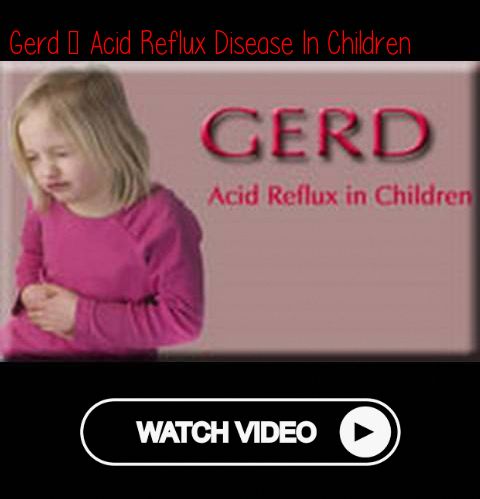 These babies do better if they are constantly fed a small amount of milk. In both of these cases, tube feedings may be suggested. Formula or breastmilk is given through a tube that is placed in the nose. This is called a nasogastric tube. The tube is then put through the food pipe or esophagus, and into the stomach. Your baby can have a tube feeding in addition to a bottle feeding. Or a tube feeding may be done instead of a bottle feeding. There are also tubes that can be used to go around, or bypass, the stomach. These are called nasoduodenal tubes.
These babies do better if they are constantly fed a small amount of milk. In both of these cases, tube feedings may be suggested. Formula or breastmilk is given through a tube that is placed in the nose. This is called a nasogastric tube. The tube is then put through the food pipe or esophagus, and into the stomach. Your baby can have a tube feeding in addition to a bottle feeding. Or a tube feeding may be done instead of a bottle feeding. There are also tubes that can be used to go around, or bypass, the stomach. These are called nasoduodenal tubes.
Surgery. In severe cases of reflux, surgery called fundoplication may be done. Your baby’s provider may recommend this option if your child is not gaining weight because of vomiting, has frequent breathing problems, or has severe irritation in the esophagus. This is often done as a laparoscopic surgery. This method has less pain and a faster recovery time. Small cuts or incisions are made in your child’s belly. A small tube with a camera on the end is placed into one of the incisions to look inside. The surgical tools are put through the other incisions. The surgeon looks at a video screen to see the stomach and other organs. The top part of the stomach is wrapped around the esophagus. This creates a tight band. This strengthens the LES and greatly decreases reflux.
The surgical tools are put through the other incisions. The surgeon looks at a video screen to see the stomach and other organs. The top part of the stomach is wrapped around the esophagus. This creates a tight band. This strengthens the LES and greatly decreases reflux.
What are the complications of GERD?
Some babies and children who have GERD may not vomit. But their stomach contents may still move up the food pipe (esophagus) and spill over into the windpipe (trachea). This can cause asthma or pneumonia.
The vomiting that affects many babies and children with GERD can cause problems with weight gain and poor nutrition. Over time, when stomach acid backs up into the esophagus, it can also lead to:
- Inflammation of the esophagus, called esophagitis
- Sores or ulcers in the esophagus, which can be painful and may bleed
- A lack of red blood cells, from bleeding sores (anemia)
Adults may also have long-term problems from inflammation of the esophagus.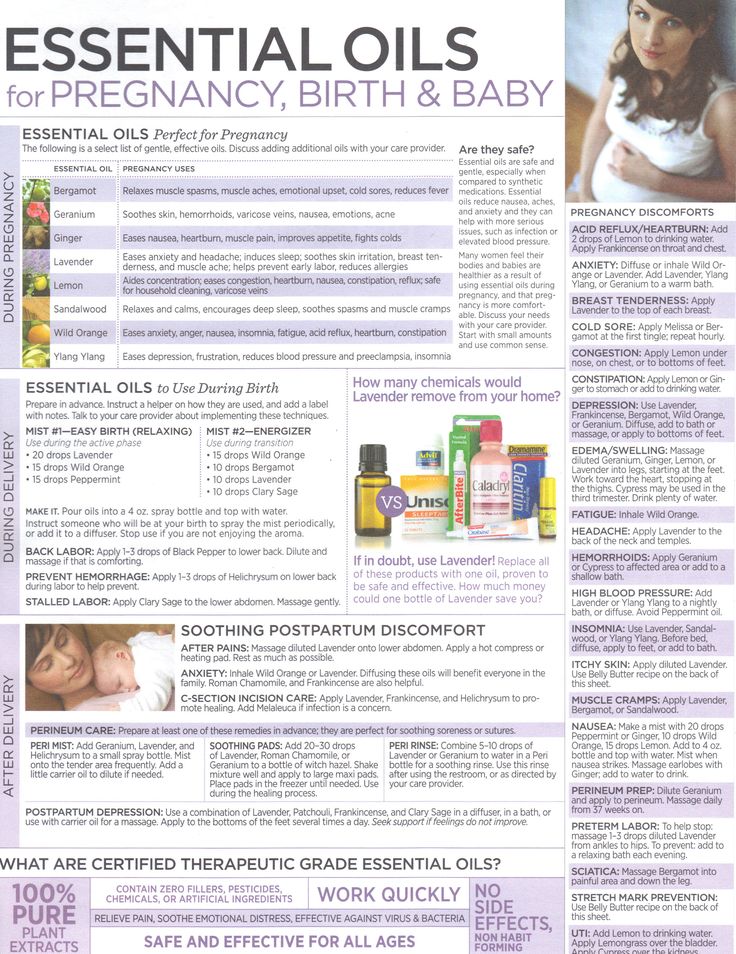 These include:
These include:
- Narrowing, or stricture, of the esophagus
- Barrett’s esophagus, a condition where there are abnormal cells in the esophageal lining
Living with GERD
Many babies who vomit outgrow it by the time they are about 1 year old. This happens as the LES gets stronger. For other children, taking medicines and making lifestyle and diet changes can reduce reflux, vomiting, and heartburn.
When should I call my child's healthcare provider?
Call you child's healthcare provider if your baby or child:
- Has reflux and is not gaining weight
- Has signs of asthma or pneumonia. These include coughing, wheezing, or trouble breathing.
Key points about GERD
- GERD is a long-term (chronic) digestive disorder.
- It happens when stomach contents come back up into the food pipe (esophagus).
- Heartburn or acid indigestion is the most common symptom of GERD.
- Vomiting can cause problems with weight gain and poor nutrition.

- In many cases, GERD can be eased by diet and lifestyle changes.
- Sometimes medicines, tube feedings, or surgery may be needed.
Next steps
Tips to help you get the most from a visit to your child’s health care provider:
- Before your visit, write down questions you want answered.
- At the visit, write down the names of new medicines, treatments, or tests, and any new instructions your provider gives you for your child.
- If your child has a follow-up appointment, write down the date, time, and purpose for that visit.
- Know how you can contact your child’s provider after office hours. This is important if your child becomes ill and you have questions or need advice.
Gastroesophageal Reflux (for Parents) - Nemours KidsHealth
What Is Gastroesophageal Reflux (GER)?
Gastroesophageal reflux (GER), also called reflux, is when food and acid from the stomach go back up into the esophagus.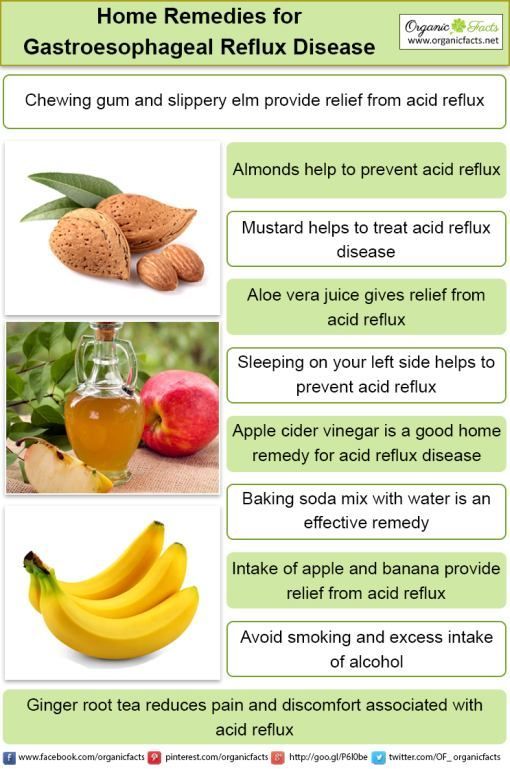 This causes an uncomfortable feeling in the chest, often called heartburn.
This causes an uncomfortable feeling in the chest, often called heartburn.
GER can happen in adults and kids, even babies. It’s normal and most kids who have gastroesophageal (gass-troh-eh-soff-eh-JEE-el) reflux outgrow it over time. Changes in diet can help, but some kids might need medical treatment.
Reflux that happens a lot and causes problems like poor growth, vomiting, or damage to the esophagus is called GERD (gastroesophageal reflux disease). GERD is more serious than GER and is usually treated with medicine.
What Are the Signs & Symptoms of Gastroesophageal Reflux?
Common signs of reflux include:
- heartburn (a burning sensation in the chest, neck, and throat). It can last up to 2 hours and tends to be worse after meals and when lying down
- burping
- frequent hiccups
- frequent spitting up or vomiting, especially after meals
- the feeling of stomach acid coming up into the back of the throat
- acidic or bad breath
- frequent cavities, especially in the back teeth, despite good brushing
Signs of GER in babies and young children include:
- choking or wheezing (if the contents of the reflux get into the windpipe and lungs)
- wet burps or wet hiccups
- spitting up that continues beyond a child's first birthday (when it stops for most babies)
- irritability or inconsolable crying after eating
- refusing to eat or eating only small amounts
- failure to gain weight
Some of these symptoms may get worse if a baby lies down or is placed in a car seat after a meal.
What Causes Gastroesophageal Reflux?
A ring of muscle, called the lower esophageal sphincter, separates the esophagus from the stomach. GER symptoms happen if this ring relaxes at the wrong time or doesn't close as it should. This lets acidic fluid from the stomach flow backward into the esophagus, into the back of the throat, and sometimes out the mouth or nose.
Often, reflux is minor and no cause for concern. But in people who have GERD, reflux happens more often and causes noticeable discomfort. After many meals, they have heartburn (also called acid indigestion).
In babies with GERD, breast milk or formula regularly refluxes into the esophagus, and sometimes out of the mouth. Sometimes babies regurgitate forcefully or have "wet burps."
What Problems Can Happen?
Babies who have GER usually outgrow it by the time they’re 1 or 2 years old. But in some cases, GER symptoms last. Kids with developmental or neurological conditions, such as cerebral palsy, are more at risk for GER and can have more severe, lasting symptoms.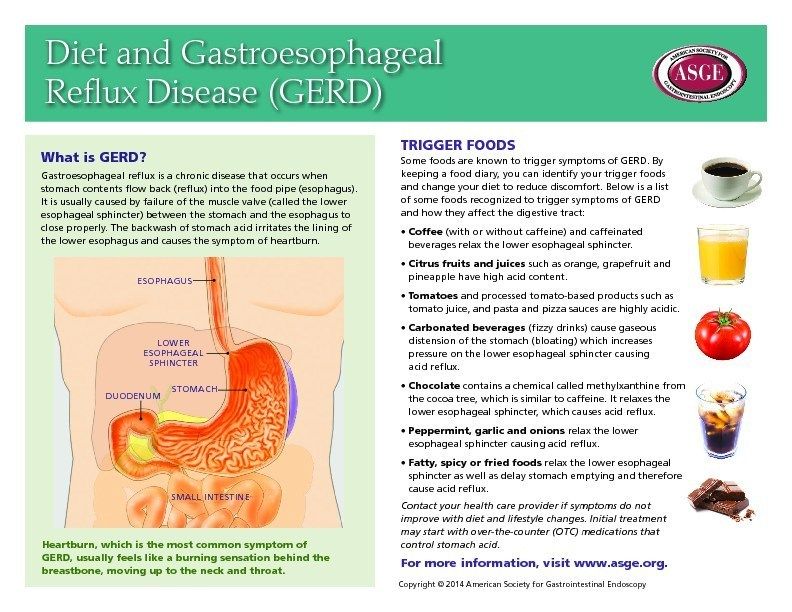
A steady reflux of stomach acid into the esophagus can lead to:
- breathing problems (if the fluid enters the trachea, lungs, or nose)
- redness and irritation in the esophagus, a condition called esophagitis
- bleeding in the esophagus
- scar tissue in the esophagus, which can make it hard to swallow
- pneumonia
- repeated asthma attacks
Because these complications can make eating painful, GER can interfere with proper nutrition. So if your child isn't gaining weight as expected or is losing weight, talk with your doctor.
How Is Gastroesophageal Reflux Diagnosed?
In older kids, doctors usually diagnose reflux by doing an exam and hearing about the symptoms. If your child has GER symptoms, try to keep track of the foods that seem to cause them. This can help the doctor figure out what's going on.
In younger children and babies, doctors might run these tests to diagnose GER or rule out other problems:
- Upper GI radiology study.
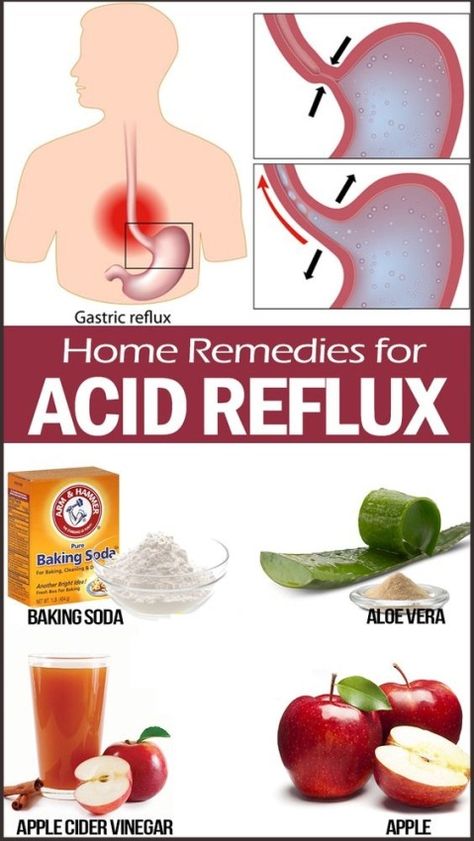 This special X-ray can show liquid backing into the esophagus, irritation or narrowing of the esophagus, and any upper digestive tract problems. For the test, your child will swallow a small amount of a chalky liquid (barium). This liquid appears on the X-ray and shows the swallowing process.
This special X-ray can show liquid backing into the esophagus, irritation or narrowing of the esophagus, and any upper digestive tract problems. For the test, your child will swallow a small amount of a chalky liquid (barium). This liquid appears on the X-ray and shows the swallowing process. - 24-hour impedance-ph probe study. This is the most accurate way to detect reflux and how often it’s happening. A thin, flexible tube goes through the nose into the esophagus. The tip rests just above the esophageal sphincter for 24 hours to check acid levels in the esophagus and to detect any reflux.
- Milk scans. This series of X-ray scans tracks a special liquid as a child swallows it. The scans can show whether the stomach is slow to empty liquids and whether the refluxed liquid is being inhaled into the lungs.
- Upper endoscopy. Doctors look at the esophagus, stomach, and part of the small intestines using a tiny fiber-optic camera.
 They also may take a small tissue sample (a biopsy) of the lining of the esophagus to rule out or find other problems.
They also may take a small tissue sample (a biopsy) of the lining of the esophagus to rule out or find other problems.
How Is Gastroesophageal Reflux Treated?
Treatment for GER depends on the symptoms and how severe they are.
Reflux is common in babies, and some simple feeding changes can help:
- Do not overfeed you baby. Smaller, more frequent feedings can reduce reflux. Talk to your health care provider about how much and how often your baby should feed.
- Burp your baby before and after feeding.
- Hold the baby upright while feeding and for 15–30 minutes after. Do not put your baby in an infant seat after feeding. This position can make reflux worse
- Talk to your health care provider before changing your baby’s diet or your diet, if you are breastfeeding.
Don’t let anyone smoke around your baby. Tobacco smoke can make reflux worse.
The doctor may recommend thickening formula with a little bit of oat infant cereal or using an anti-reflux formula to reduce reflux. Breastfed infants with reflux should continue to breastfeed. Talk to your doctor before thickening feedings if your infant is breastfeeding, overweight, or was born early.
Breastfed infants with reflux should continue to breastfeed. Talk to your doctor before thickening feedings if your infant is breastfeeding, overweight, or was born early.
Older kids often get relief by avoiding foods and drinks that trigger GER symptoms. Often, these include:
- citrus fruits
- chocolate
- food and drinks with caffeine
- fatty and fried foods
- garlic and onions
- spicy foods
- tomato-based foods and sauces
- peppermint
Doctors may recommend raising the head of an older child's bed 6 to 8 inches to help with reflux that happens at night. Infants younger than 1 year old, including infants with gastroesophageal reflux, should always sleep on their backs on a flat, firm surface.
Obesity, some medicines, smoking and alcohol can make GER worse.
If symptoms continue, doctors might prescribe medicine, such as:
- h3 blockers, which can help block the production of stomach acid
- proton pump inhibitors, which reduce the amount of acid the stomach makes
- prokinetics, which help the esophageal sphincter work better and the stomach empty faster.
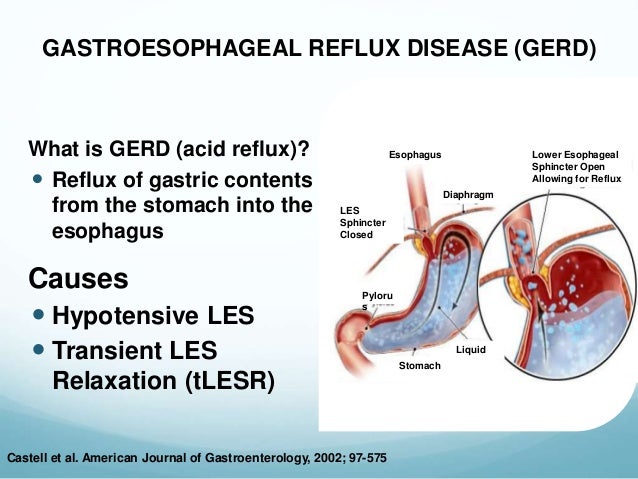 This can prevent reflux episodes.
This can prevent reflux episodes.
Rarely, medical treatment alone doesn't help and a child fails to grow well or has other problems. Then, a surgical procedure might be an option. In this surgery, called fundoplication (fun-doh-plih-KAY-shun), the doctor creates a valve at the top of the stomach by wrapping part of the stomach around the esophagus to strengthen the sphincter and prevent reflux.
When Should I Call the Doctor?
Call the doctor if your baby has GER and:
- does not seem to be growing
- cries a lot more than usual
- won't eat, or cries and arches away from the bottle or breast during feedings
- coughs, chokes, wheezes, or has trouble breathing
- has forceful vomiting more than a few times in a 24-hour period
- has blood in the poop
- still has problems with reflux after age 1
Go to the ER right away if your baby throws up blood or bile (a green or yellow liquid).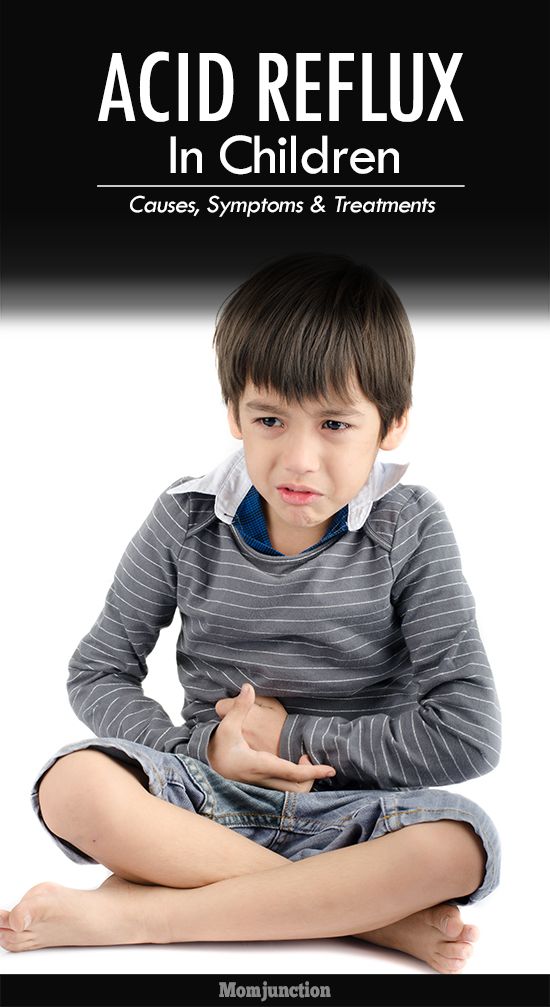
Call your doctor if an older child with GER:
- is very bothered by the reflux
- does not seem to be growing
- coughs, chokes, wheezes, or has trouble breathing
- vomits more than a few times in a 24-hour period
- has blood in the poop
Go to the ER right away if your child has severe chest pain.
What Else Should I Know?
If your child has GER:
- Encourage them to eat smaller meals more often instead of three large meals.
- Talk to the doctor about safe weight loss if your child is overweight or obese.
- Don't let anyone smoke near your child. It can make the reflux worse.
Infant Reflux: Symptoms and Treatment
Search Support IconSearch Keywords
Home ›› What is Reflux in Infants?
Home ›› What is reflux in babies?
↑ Top
Signs and what to do
Post-feed regurgitation is a common occurrence in the first few months of life.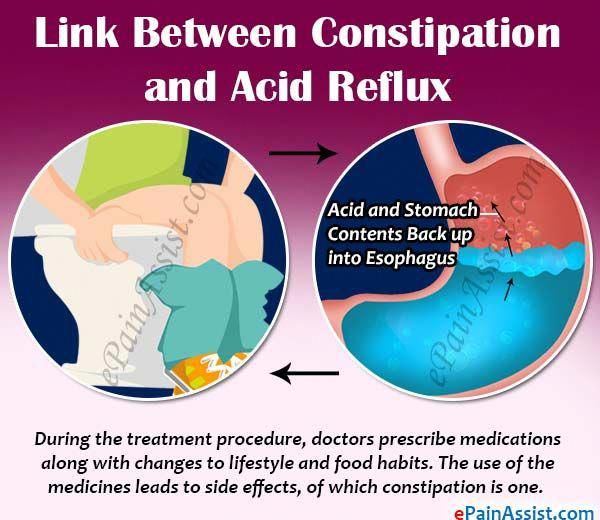 This is usually harmless and completely normal, but parents should read about gastroesophageal reflux (GER) and laryngopharyngeal reflux (LPR) in infants and how long it lasts to give them peace of mind. nine0019
This is usually harmless and completely normal, but parents should read about gastroesophageal reflux (GER) and laryngopharyngeal reflux (LPR) in infants and how long it lasts to give them peace of mind. nine0019
We look at signs of reflux in babies, symptoms of different types of reflux, and how to help a child with signs of reflux. If you require further information, always contact your healthcare provider.
What is reflux in babies?
So we know reflux is common, but what causes reflux in babies? Because young children have not yet fully developed the lower esophageal sphincter (LES), that is, the muscle at the bottom of the esophagus that opens and closes to let food into the stomach and keep it there, food can easily pass back up the esophagus. nine0003
Acid reflux, also known as gastroesophageal reflux (GER), is a normal reflux that occurs in babies. This type of reflux is considered normal and occurs in 40-65% of babies.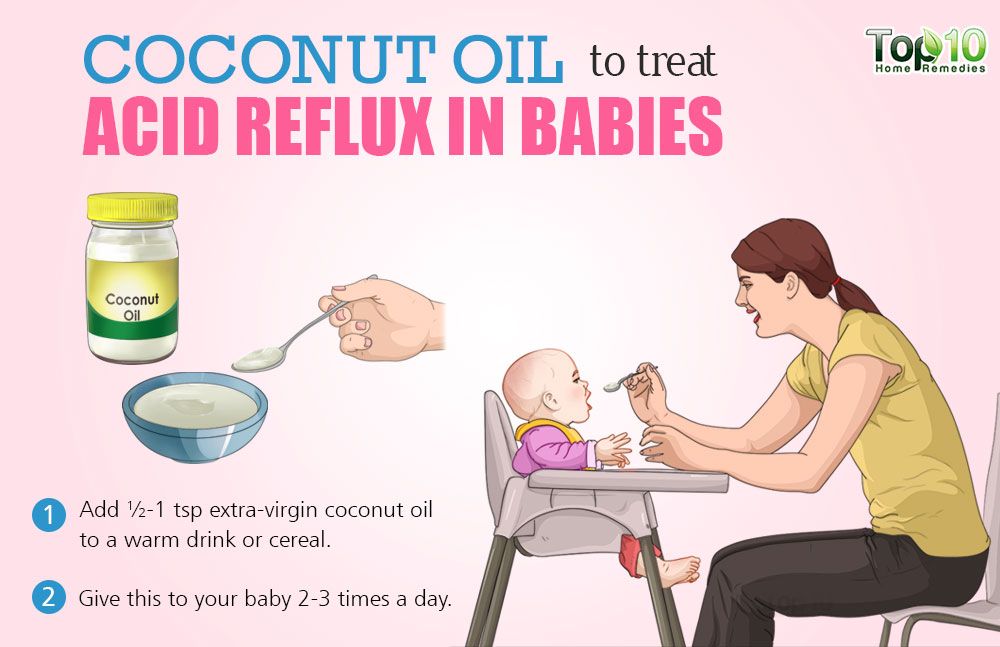
How do I know if my child has acid (gastroesophageal) reflux?
If a baby is spitting up milk after a feed, it is most likely acid reflux. As babies get older, GER usually goes away on its own without any intervention. If a baby has complications beyond just spitting up a small amount of milk (such as feeding difficulties and discomfort), they may have gastroesophageal reflux disease (GERD). nine0019
Symptoms of GERD include:
- baby arching during or after feeding;
- crying more than three hours a day for no apparent reason;
- cough;
- gag reflex or difficulty swallowing;
- irritability, restlessness after eating;
- eating little or not eating;
- poor weight gain or loss;
- difficult breathing;
- severe or frequent vomiting. nine0019
GERD usually occurs when LES muscles are not toned in time, causing stomach contents to back up into the esophagus.
How do I know if my child has Laryngopharyngeal Reflux?
Another type of reflux, laryngopharyngeal reflux (LPR), also called silent reflux, is when the contents of the baby's stomach leak back into the larynx, the back of the nasopharynx. This type of reflux does not always cause external symptoms, which is why it is called "silent". Babies can have GERD and silent reflux at the same time, but their symptoms are somewhat different. nine0019
The following are some of the symptoms of laryngopharyngeal reflux:
- breathing problems;
- gag reflex;
- chronic cough;
- swallowing problems;
- hoarseness;
- regurgitation;
- poor weight gain or weight loss.
We have looked at the signs of reflux in infants, now we will move on to the treatment and duration of silent reflux in children, as well as the treatment of GERD. nine0003
How to deal with laryngopharyngeal reflux in babies while breastfeeding?
Breastfeeding mothers may need to review their diet if their babies show signs of reflux. The American Academy of Pediatrics (AAP) recommends breastfeeding mothers cut eggs and milk from their diet for two to four weeks to see if their baby's reflux symptoms improve or disappear. It may be worth eliminating acidic foods from your diet. nine0019
The American Academy of Pediatrics (AAP) recommends breastfeeding mothers cut eggs and milk from their diet for two to four weeks to see if their baby's reflux symptoms improve or disappear. It may be worth eliminating acidic foods from your diet. nine0019
In most cases, GER and laryngopharyngeal reflux go away on their own. Typically, children outgrow reflux in the first year of life. If a child has persistent symptoms of laryngopharyngeal reflux, parents should consult a doctor. If your baby has severe vomiting, blood in the stool, or any of the symptoms of GERD listed above, parents should contact their pediatrician as soon as possible.
How can I help my child with reflux or GERD? nine0008
Reflux symptoms in babies usually go away on their own, but the following tips can help relieve symptoms:
- Thicken food with rice or a special milk thickener.
- Hold the bottle at an angle that fills the nipple completely with milk to reduce the amount of air your baby swallows.
 This can help prevent colic, gas, and reflux.
This can help prevent colic, gas, and reflux. - Try the AirFree anti-colic bottle, designed to reduce air swallowing during feeding. nine0047
4. Let the baby burp during and after feeding. If the baby is bottle fed, parents can let him burp after every 30-60 ml. If the mother is breastfeeding, she may let the baby burp when changing breasts.
5. Hold baby upright after feeding. As a rule, in order for the milk to remain in the stomach, after feeding the baby, it is necessary to hold it in an upright position for 10-15 minutes. But, if the child has reflux, parents should keep him upright a little longer. nine0003
These tips may help relieve symptoms, but they do not replace a doctor's advice.
Parents should not change their infant formula formula without first talking to their healthcare provider.
Don't panic! Reflux is very common in babies during the first three months of life, and most babies outgrow it without any consequences.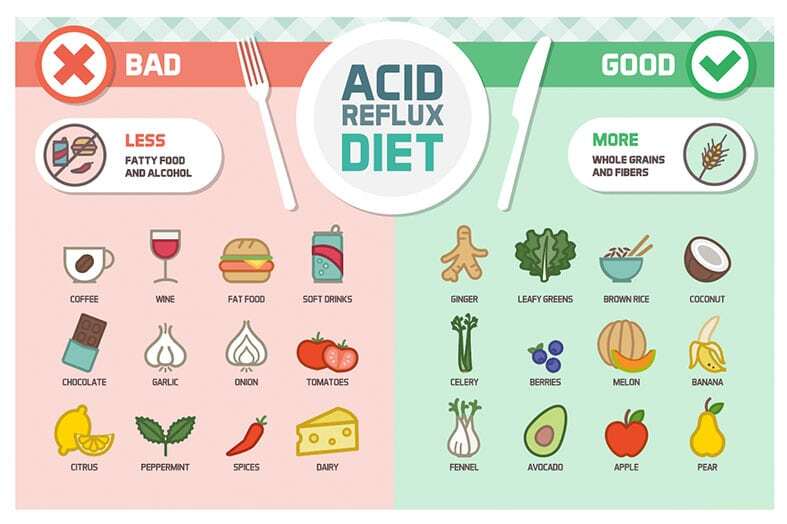 Although GERD is a slightly more serious condition, there are many treatments, ways to manage it, and help newborns. Feel free to contact your doctor with any questions or concerns you may have. nine0003
Although GERD is a slightly more serious condition, there are many treatments, ways to manage it, and help newborns. Feel free to contact your doctor with any questions or concerns you may have. nine0003
4 Seattle Children’s Hospital
5 The National Institute of Diabetes and Digestive and Kidney Diseases - Treatment for GER & GERD in Infants
Any links to third party websites that may be included on this site are provided solely as a convenience to you. Philips makes no warranties regarding any third party websites or the information they contain. nine0003
I understand
You are about to visit a Philips global content page
Continue
You are about to visit the Philips USA website.
I understand
Medicines for children with gastroesophageal reflux
Survey question
Reflux symptoms in most infants will gradually stop by the time they start eating solid foods and spend more time upright, and as the esophagus grows in length, but do medications help make this period [of symptoms] more comfortable? Older children may have heartburn, just as adults do.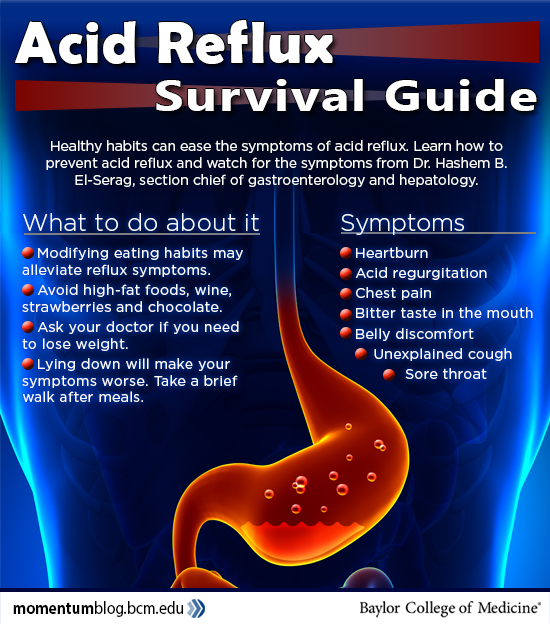 What type of treatment [for symptoms] works best in these situations? nine0003
What type of treatment [for symptoms] works best in these situations? nine0003
Relevance
Gastro-esophageal (gastroesophageal) reflux occurs when stomach contents back up into the esophagus. This may be a normal variant ("functional reflux"), but in some children and many infants it [reflux] can occur very frequently, or may cause symptoms such as pain, weight loss, or other problems (such as ear infections, coughing, and even stops (pauses) in breathing). If this occurs, the condition may be referred to as gastroesophageal reflux disease (GERD) Sometimes the esophagus becomes inflamed, a condition known as "esophagitis." nine0003
Existing medications (eg Gaviscon Infant; Gaviscon Infant ® ) aim to thicken stomach contents, neutralize stomach acid (ranitidine, omeprazole, lansoprazole), or promote faster gastric emptying (dommperidone). We reviewed all available studies to try to find out if any of the existing medications can help infants and children with reflux. We wanted to know if these medications make infants and children feel better, or if they improve test results (eg, healing of the esophageal mucosa as assessed by endoscopy (small chamber down the esophagus) or decreased acidity in the esophagus as measured by a pH probe over 24 hours) when children take these medicines. nine0003
We wanted to know if these medications make infants and children feel better, or if they improve test results (eg, healing of the esophageal mucosa as assessed by endoscopy (small chamber down the esophagus) or decreased acidity in the esophagus as measured by a pH probe over 24 hours) when children take these medicines. nine0003
Study profile
We included all studies (randomized controlled trials) comparing one type of drug against another or against an inactive drug (placebo). We carefully reviewed the results of the studies and attempted to evaluate those that would be important to clinicians, nurses, and parents. We found: the many differences between studies, and the small number of children included in these studies, the short follow-up period, and differing outcomes, all made pooling the data (meta-analysis) difficult. nine0003
Main results
In general, due to the small number of children included in these studies, we cannot be sure that these drugs improve [suppress] symptoms.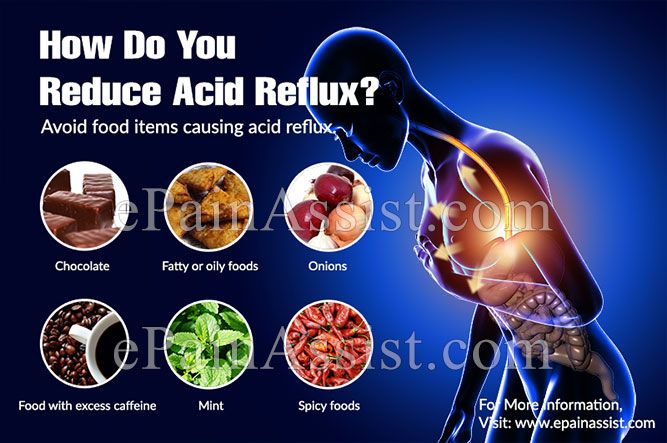 We found little evidence that drugs work [work] in children under the age of one years, especially with functional reflux; mixed evidence was found as to whether Gaviscon Infant ® helps and that in children with reflux disease (changes on pH testing or on endoscopy), medications such as omeprazole and lansoprazole are likely to help. pH results, but we were unable to perform a meta-analysis, or assess whether one drug is superior to another. nine0003
We found little evidence that drugs work [work] in children under the age of one years, especially with functional reflux; mixed evidence was found as to whether Gaviscon Infant ® helps and that in children with reflux disease (changes on pH testing or on endoscopy), medications such as omeprazole and lansoprazole are likely to help. pH results, but we were unable to perform a meta-analysis, or assess whether one drug is superior to another. nine0003
Quality of evidence
Overall, the available evidence was of moderate to low quality, depending on the drug being studied. We made suggestions on how future studies could be designed to better answer the question of what treatment is best for infants and children with reflux or reflux. disease.
Translation notes:
Translation: Yudina Ekaterina Viktorovna. Editing: Ziganshina Lilia Evgenievna. Russian translation project coordination: Kazan Federal University.
